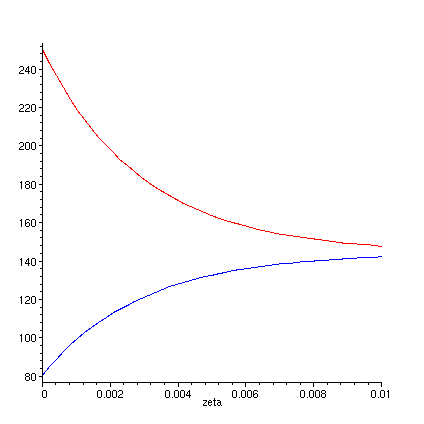Solution to Sample Problem :
Part A:
Executing example 15.4-2 for counter flow:
> restart;
> eqh:=w*Cph*D(Th)(z)=U0*2*Pi*r0*(Tc(z)-Th(z)); Balance on the hot side using eq. 15.4-10 and eq. 13.1-8.
![]()
> eqc:=w*Cpc*D(Tc)(z)=U0*2*Pi*r0*(Th(z)-Tc(z)); Balance on the cold side.
![]()
> s:=dsolve({eqh,eqc,Tc(0)=Tc1,Th(0)=Th1},{Tc(z),Th(z)}):
> assign(s); Th:=unapply(Th(z),z);Tc:=unapply(Tc(z),z);
![[Maple Math]](images/sol3.gif)
![[Maple Math]](images/sol4.gif)
Temperature changes for counter flow:
> dT1:=simplify(Th(0)-Tc(L));
![[Maple Math]](images/sol5.gif)
> dT2:=simplify(Th(L)-Tc(0));
![[Maple Math]](images/sol6.gif)
> log(dT1/dT2);
![[Maple Math]](images/sol7.gif)
> logdT12:=simplify(%,assume=positive);
![[Maple Math]](images/sol8.gif)
> Cpc:=-Qh/(wc*(Tc2-Tc1)); Using eq. 15.4-9 and the fact that Qc=-Qh.
![]()
> Cph:=Qh/(wh*(Th2-Th1)); Using eq. 15.4-8.
![]()
> logdT12;
![[Maple Math]](images/sol11.gif)
![[Maple Math]](images/sol12.gif)
> Qc:=solve(-logdT12=logdT21,Qh);
![[Maple Math]](images/sol13.gif)
Therefore, for the different temperature changes for counter flow, Qc is:
> Qc:=(UA,Tc2,Tc1,Th2,Th1)->UA*((Th1-Tc2)-(Th2-Tc1))/log((Th1-Tc2)/(Th2-Tc1));
![[Maple Math]](images/sol14.gif)
> wh:= 12000*(lbm/hr); wc:= 7000*(lbm/hr); Tc1:=80*F; Th1:=250*F; Th2:=150*F ; Cpc:=1*(Btu/(lbm*F)); Cph:= 0.6*(Btu/(lbm*F)); Uo:= 200*(Btu/(hr*ft^2*F)); These are the parameters given in the problem.
![]()
![]()
![]()
![]()
![]()
![]()
![]()
![[Maple Math]](images/sol22.gif)
> Qhspec:=wh*(Th2 - Th1)*Cph;
![]()
> Tc2:=(solve(-Qhspec=wc*(Tc2-Tc1)*Cpc,Tc2));
![]()
> UA:=solve(-Qhspec=Qc(UA,Tc2,Tc1,Th2,Th1),UA);
![]()
> A:= UA/Uo;
![]()
To view the temperature profile for this situation, click on the following link: Matlab Heat Exchanger Program
Part B:
> U1:= 50*(Btu/(hr*ft^2*F)); U2:= 350*(Btu/(hr*ft^2*F)); Th1:= 150*F; Th2:= 250*F; Tc1:= 80*F; Tc2:= 182.857*F;
![[Maple Math]](images/sol27.gif)
![[Maple Math]](images/sol28.gif)
![]()
![]()
![]()
![]()
> A:= 'A';
![]()
> A:= (-Qhspec)*(((U1*(Th2-Tc2) - U2*(Th1-Tc1)))/(ln((U1*(Th2-Tc2)/(U2*(Th1-Tc1))))))^(-1);
![]()
Part C:
The key to this problem is that the oil and water temperatures a surface 2 will be the same.
For counterflow:
> Tc2:=250*F;
![]()
> wc:='wc';
![]()
> Qc:=wc*Cpc*(Tc2-Tc1)=-Qhspec;
![]()
> wc:=solve(Qc,wc);
![]()
For parallel flow:
> wh:=12000*(lbm/hr);wc:='wc';Cph:=0.6*(Btu/(lbm*F));Cpc:=1.0*(Btu/(lbm*F)); U0:=200*(Btu/(hr*ft^2*F));
![]()
![]()
![]()
![]()
![[Maple Math]](images/sol43.gif)
> Th1:=250*F;Th2:=150*F;Tc1:=80*F;Tc2:= Th2;
![]()
![]()
![]()
![]()
> Qh:=wh*Cph*(Th2-Th1);
![]()
> Qc:=wc*Cpc*(Tc2-Tc1)=-Qh;
![]()
> wc:=solve(Qc,wc);
![]()
Part D:
Executing example 15.4-2 for parallel flow:
> restart;
> eqh:=w*Cph*D(Th)(z)=U0*2*Pi*r0*(Tc(z)-Th(z)); Balance on the hot side using eq. 15.4-10 and eq. 13.1-8.
![]()
> eqc:=w*Cpc*D(Tc)(z)=U0*2*Pi*r0*(Th(z)-Tc(z)); Balance on the cold side.
![]()
> s:=dsolve({eqh,eqc,Tc(0)=Tc1,Th(0)=Th1},{Tc(z),Th(z)}):
> assign(s); Th:=unapply(Th(z),z);Tc:=unapply(Tc(z),z);
![[Maple Math]](images/sol53.gif)
![[Maple Math]](images/sol54.gif)
Temperature changes for parallel flow:
> dT1:=simplify(Th(0)-Tc(0));
![]()
> dT2:=simplify(Th(L)-Tc(L));
![[Maple Math]](images/sol56.gif)
> log(dT1/dT2);
![[Maple Math]](images/sol57.gif)
> logdT12:=simplify(%,assume=positive); Agrees with eq. 15.4-14
![]()
> Cpc:=-Qh/(wc*(Tc2-Tc1)); Using eq. 15.4-9 and the fact that Qc=-Qh.
![]()
> Cph:=Qh/(wh*(Th2-Th1)); Using eq. 15.4-8.
![]()
> logdT12;
![[Maple Math]](images/sol61.gif)
> Qc:=solve(-logdT12=logdT21,Qh); eq. 15.4-15
![]()
In this last expression, logdT21 is log(dT2/dT1) which is -log(dT1/dT2) or log((Th2-Tc2)/(Th1-Tc1)). Therefore, for parallel flow, Qc is:
> Qc:=(UA,Tc2,Tc1,Th2,Th1)->UA*((Th2-Tc2)-(Th1-Tc1))/log((Th2-Tc2)/(Th1-Tc1));
![[Maple Math]](images/sol63.gif)
> wh:= 12000*(lbm/hr); wc:= 12000*(lbm/hr); Tc1:=80*F; Th1:=250*F; Th2:=150*F ; Cpc:=1*(Btu/(lbm*F)); Cph:= 0.6*(Btu/(lbm*F)); Uo:= 200*(Btu/(hr*ft^2*F)); These are the parameters given in the problem.
![]()
![]()
![]()
![]()
![]()
![]()
![]()
![[Maple Math]](images/sol71.gif)
> Qhspec:=wh*(Th2 - Th1)*Cph;
![]()
> Tc2:=(solve(-Qhspec=wc*(Tc2-Tc1)*Cpc,Tc2));
![]()
> UA:=solve(-Qhspec=Qc(UA,Tc2,Tc1,Th2,Th1),UA);
![]()
> A:= UA/Uo;
![]()
Plotting temperature profile:
> simplify(Th(zeta*(A*Btu*w/r0/F/U0/Pi/ft^2/lbm))/F);
![]()
> simplify(Tc(zeta*(A*Btu*w/r0/F/U0/Pi/ft^2/lbm))/F);
![]()
> plot({Th(zeta*(A*Btu*w/r0/F/U0/Pi/ft^2/lbm))/F,Tc(zeta*(A*Btu*w/r0/F/U0/Pi/ft^2/lbm))/F},zeta=0...0.01,color=[red,blue]);

As one can see, this is a very inefficient way to operate a heat exchanger because the temperature differnce tends to converge and is not constant throughout the heat exchanger..